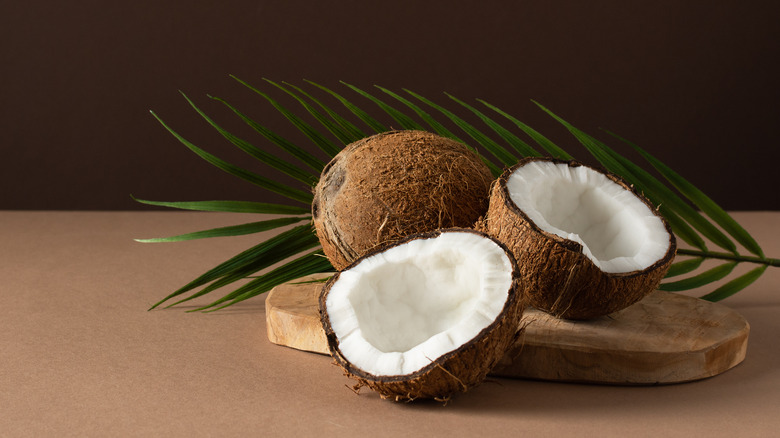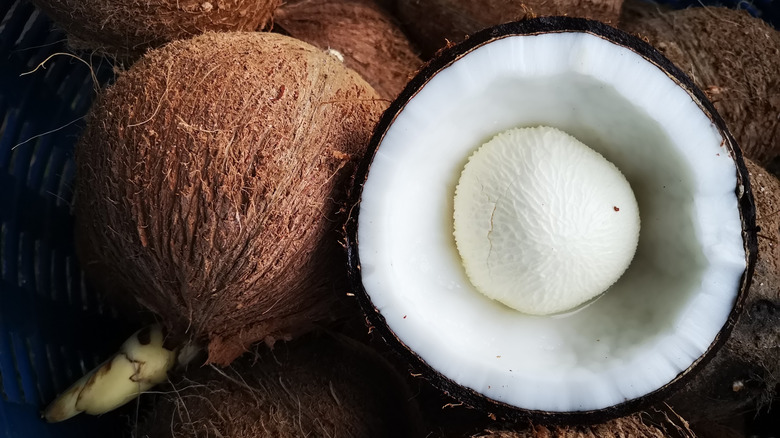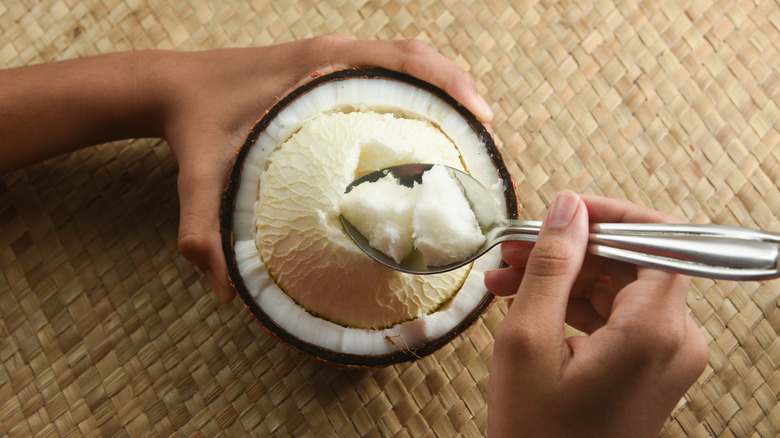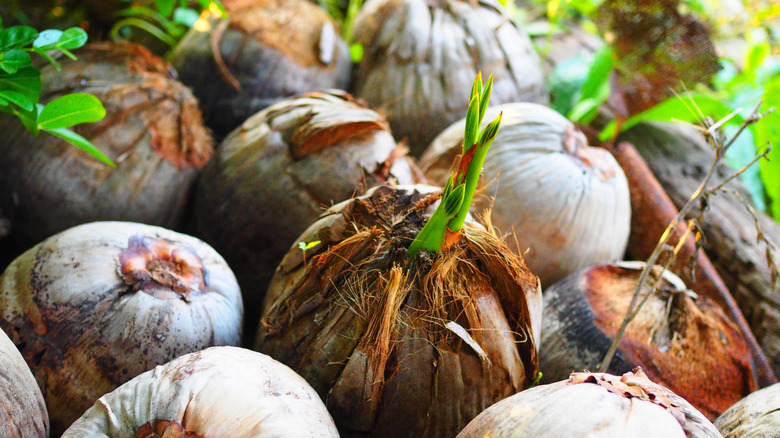What Is A Coconut Embryo And Can Eating One Make You Sick?
A fresh coconut may conjure up thoughts of beachy destinations or your favorite sweet treats. This internationally-adored fruit (yes, it is a fruit, not a nut) is coveted globally for its versatility and fruity, aromatic white meat.
In India, coconuts are a symbol of prosperity and used in many important ceremonies, according to The Journal of Ethnic Foods. The coconut tree is called "Kalpavriksha" in Sanskrit, meaning "the tree that provides the essentials of life." All across Southeast Asia, shorter variations on the name are used such as "tree of life" and "tree of abundance." This region has incorporated the coconut into popular foods like coconut curry, coconut chutney, and coconut rice.
Part of the popularity around coconuts revolves around its versatility. The iconic white meat of the coconut can be eaten raw or cooked. Both the coconut milk and water can be enjoyed fresh or from a bottle. And, coconut cream and coconut oil are coveted byproducts. Even the shell can be repurposed, with options of turning it into serving bowls, planters, or bird feeders.
However, another lesser-known part of the coconut can also be consumed: the coconut embryo. While it may not sound appetizing, there's a few reasons you should give it a try.
What is a coconut embryo?
To understand what exactly a coconut embryo is, it may be helpful to break down the anatomy of a coconut.
According to Coco and Coir, a mature coconut has an outer layer that is not the iconic brown, wiry husk we think of. The outer fruit skin, known as the "exocarp," is smooth and green. When harvested, the outer layer is shucked, revealing the fibrous brown husk or "mesocarp." This husk is peeled off, revealing the coconut shell. This "endocarp" is what protects the white fruit inside.
When a coconut becomes over-mature, it can start sprouting, becoming a germinated coconut (via The Produce Nerd). Once sprouted, the seed inside the shell begins to "consume the water, developing into a solid, spongy mass," according to Specialty Produce. When opened, instead of seeing the hollow, watery center, you will see the embryo, a large, yellowy mass that is known as the coconut "apple" (via The Produce Nerd).
This part of the coconut is completely edible — and it will not make you sick.
How to eat a coconut embryo
It's no secret: Coconuts are hard to crack. And, sprouted coconuts are no different. You can use a cleaver, or another type of large knife.If those don't prove successful, another method is to put the coconut inside a towel and swing it against a hard surface.
Once opened, it is recommended to eat the embryo raw (via Specialty Produce). The soft, airy texture is part of the experience and it will lose it if cooked. You can dig right into the center with a spoon or cube it up and serve it on platters. And if you prefer, you can mix the cubes into fruit salads for more variety in flavor (via Specialty Produce).
However, it is always recommended to get creative. You can bake it or mix it into anything you want. Miami Fruit has even used it as a bread replacement, serving it as a burger bun with lettuce, tomato and vegan patties.
What does coconut embryo taste like?
The coconut embryo's taste is pretty mild and does not have as much flavor as the fruit of the coconut. But, the taste is still pleasantly enjoyable. According to Miami Fruit, each sprouted coconut embryo has a unique flavor that varies from mildly sweet to surprisingly salty. The outer skin on the embryo contains the most flavor, while the pillowy inside is milder.
While this part of the coconut tastes good, it is also nutritious. There are a myriad of health benefits that can be gained by enjoying a coconut embryo.
According to Specialty Produce, sprouted coconuts are an excellent source of both vitamins and minerals. It has a good amount of vitamin C, which is known to strengthen the immune system. They also note it is high in omega-3 and omega-6 fatty acids, making it heart-healthy (via Harvard Health Publishing). Coconuts are also good sources for fiber, potassium, and iron.



